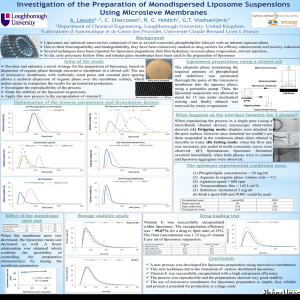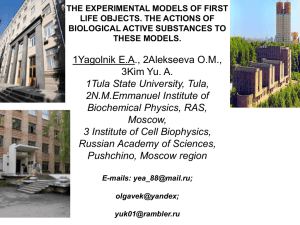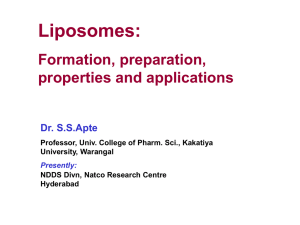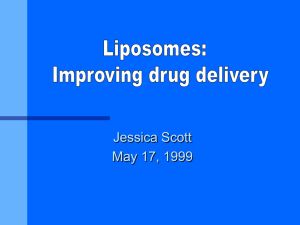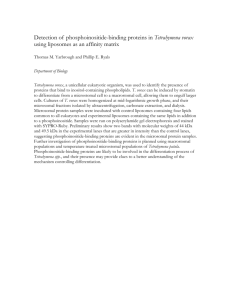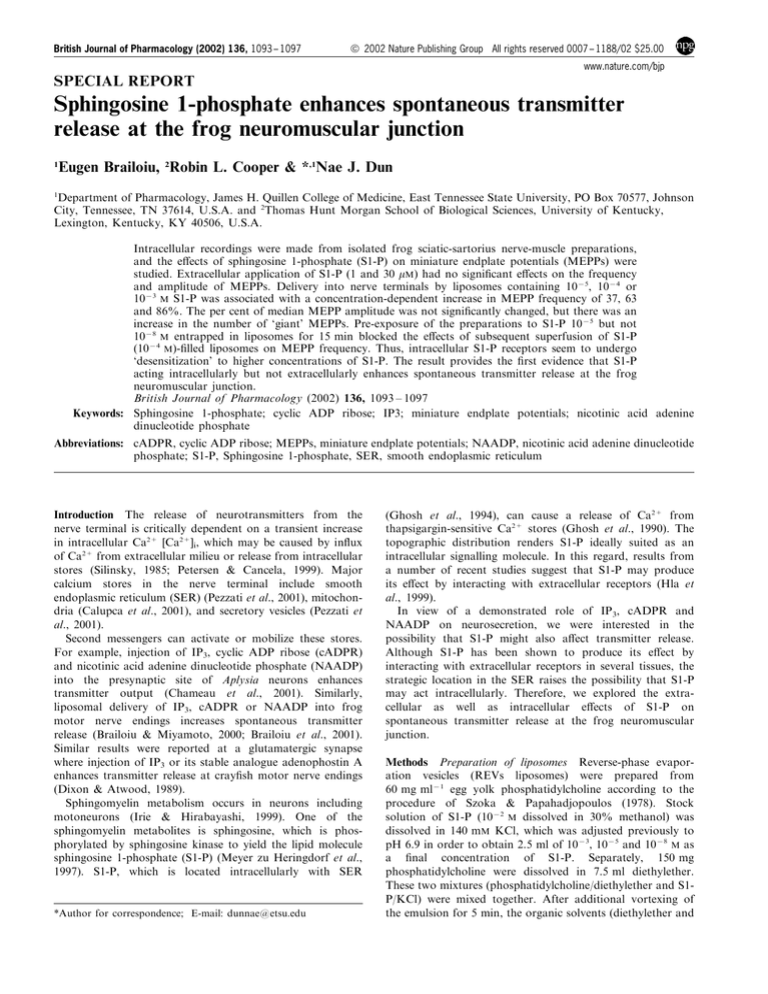
British Journal of Pharmacology (2002) 136, 1093 ± 1097
ã 2002 Nature Publishing Group All rights reserved 0007 ± 1188/02 $25.00
www.nature.com/bjp
SPECIAL REPORT
Sphingosine 1-phosphate enhances spontaneous transmitter
release at the frog neuromuscular junction
Eugen Brailoiu, 2Robin L. Cooper & *,1Nae J. Dun
1
1
Department of Pharmacology, James H. Quillen College of Medicine, East Tennessee State University, PO Box 70577, Johnson
City, Tennessee, TN 37614, U.S.A. and 2Thomas Hunt Morgan School of Biological Sciences, University of Kentucky,
Lexington, Kentucky, KY 40506, U.S.A.
Intracellular recordings were made from isolated frog sciatic-sartorius nerve-muscle preparations,
and the eects of sphingosine 1-phosphate (S1-P) on miniature endplate potentials (MEPPs) were
studied. Extracellular application of S1-P (1 and 30 mM) had no signi®cant eects on the frequency
and amplitude of MEPPs. Delivery into nerve terminals by liposomes containing 1075, 1074 or
1073 M S1-P was associated with a concentration-dependent increase in MEPP frequency of 37, 63
and 86%. The per cent of median MEPP amplitude was not signi®cantly changed, but there was an
increase in the number of `giant' MEPPs. Pre-exposure of the preparations to S1-P 1075 but not
1078 M entrapped in liposomes for 15 min blocked the eects of subsequent superfusion of S1-P
(1074 M)-®lled liposomes on MEPP frequency. Thus, intracellular S1-P receptors seem to undergo
`desensitization' to higher concentrations of S1-P. The result provides the ®rst evidence that S1-P
acting intracellularly but not extracellularly enhances spontaneous transmitter release at the frog
neuromuscular junction.
British Journal of Pharmacology (2002) 136, 1093 ± 1097
Keywords: Sphingosine 1-phosphate; cyclic ADP ribose; IP3; miniature endplate potentials; nicotinic acid adenine
dinucleotide phosphate
Abbreviations: cADPR, cyclic ADP ribose; MEPPs, miniature endplate potentials; NAADP, nicotinic acid adenine dinucleotide
phosphate; S1-P, Sphingosine 1-phosphate, SER, smooth endoplasmic reticulum
Introduction The release of neurotransmitters from the
nerve terminal is critically dependent on a transient increase
in intracellular Ca2+ [Ca2+]i, which may be caused by in¯ux
of Ca2+ from extracellular milieu or release from intracellular
stores (Silinsky, 1985; Petersen & Cancela, 1999). Major
calcium stores in the nerve terminal include smooth
endoplasmic reticulum (SER) (Pezzati et al., 2001), mitochondria (Calupca et al., 2001), and secretory vesicles (Pezzati et
al., 2001).
Second messengers can activate or mobilize these stores.
For example, injection of IP3, cyclic ADP ribose (cADPR)
and nicotinic acid adenine dinucleotide phosphate (NAADP)
into the presynaptic site of Aplysia neurons enhances
transmitter output (Chameau et al., 2001). Similarly,
liposomal delivery of IP3, cADPR or NAADP into frog
motor nerve endings increases spontaneous transmitter
release (Brailoiu & Miyamoto, 2000; Brailoiu et al., 2001).
Similar results were reported at a glutamatergic synapse
where injection of IP3 or its stable analogue adenophostin A
enhances transmitter release at cray®sh motor nerve endings
(Dixon & Atwood, 1989).
Sphingomyelin metabolism occurs in neurons including
motoneurons (Irie & Hirabayashi, 1999). One of the
sphingomyelin metabolites is sphingosine, which is phosphorylated by sphingosine kinase to yield the lipid molecule
sphingosine 1-phosphate (S1-P) (Meyer zu Heringdorf et al.,
1997). S1-P, which is located intracellularly with SER
*Author for correspondence; E-mail: dunnae@etsu.edu
(Ghosh et al., 1994), can cause a release of Ca2+ from
thapsigargin-sensitive Ca2+ stores (Ghosh et al., 1990). The
topographic distribution renders S1-P ideally suited as an
intracellular signalling molecule. In this regard, results from
a number of recent studies suggest that S1-P may produce
its eect by interacting with extracellular receptors (Hla et
al., 1999).
In view of a demonstrated role of IP3, cADPR and
NAADP on neurosecretion, we were interested in the
possibility that S1-P might also aect transmitter release.
Although S1-P has been shown to produce its eect by
interacting with extracellular receptors in several tissues, the
strategic location in the SER raises the possibility that S1-P
may act intracellularly. Therefore, we explored the extracellular as well as intracellular eects of S1-P on
spontaneous transmitter release at the frog neuromuscular
junction.
Methods Preparation of liposomes Reverse-phase evaporation vesicles (REVs liposomes) were prepared from
60 mg ml71 egg yolk phosphatidylcholine according to the
procedure of Szoka & Papahadjopoulos (1978). Stock
solution of S1-P (1072 M dissolved in 30% methanol) was
dissolved in 140 mM KCl, which was adjusted previously to
pH 6.9 in order to obtain 2.5 ml of 1073, 1075 and 1078 M as
a ®nal concentration of S1-P. Separately, 150 mg
phosphatidylcholine were dissolved in 7.5 ml diethylether.
These two mixtures (phosphatidylcholine/diethylether and S1P/KCl) were mixed together. After additional vortexing of
the emulsion for 5 min, the organic solvents (diethylether and
1094
E. Brailoiu et al
Special Report
Figure 1 Sample recordings of miniature endplate potentials (MEPPs) in normal Ringer solution before, during, and after
superfusion of S1-P (1073 M) entrapped in liposomes. Note the increase in MEPP frequency and the presence of `giant' MEPPs
during S1-P superfusion.
Preparations and solutions Frogs (Rana pipiens) were
decapitated and rapidly double-pithed, and sciatic-sartorius
nerve-muscle preparations were isolated. Every eort was
made to use the minimum number of animals required for
valid statistical analyses. Procedures were reviewed and
approved by the East Tennessee State University
Committee for Animal Care. Muscles were mounted in a 3ml Sylgard-lined Petri dish bath, which was continuously
perfused with Ringer solution using a dual-chambered roller
pump. The Ringer solution contained (mM): 110 NaCl, 2.5
KCl, 1.8 CaCl2, 2.0 tris(hydroxymethyl) aminomethane (Tris,
pH 7.2) and 5.6 glucose.
Figure 2 Percent changes in MEPP frequency as a function of time.
The eects of 1075, 1074 and 1073 M S1-P delivered by liposomes (L
S1-P) on MEPP frequency are superimposed for comparison. The
peak eect occurs at 3 min for 1074 and 1073 M, and at 4 min for
1075 M S1-P. MEPP frequency 100%=0.974 s71 (1075 M S1-P),
1.12 s71 (1074 M S1-P) and 0.983 s71 (1073 M S1-P). Note that the
MEPP frequency return to control level, e.g., at time=8 min for S1-P
1075 M. Each point represents the mean from six dierent
experiments. Asterisks denote statistically signi®cant dierences
(P50.05) from control.
methanol) were evaporated in vacuo using a rotary
evaporator at 208C. Liposome batches were dialyzed (Sigma
dialysis sacs) against control Ringer solution (1/600 (v v71,
150 min) to remove non-incorporated agent, and the Ringer
solution was changed every 30 min. Control liposomes were
similarly made, except 2.25 ml of 140 mM KCl solution were
dissolved in 0.25 ml of 30% methanol. Liposome suspensions
were administered by continuous perfusion (1.5 ml min71)
after 1/20 (v v71) dilution in control Ringer solution.
British Journal of Pharmacology vol 136 (8)
Electrophysiological techniques MEPPs were recorded using
conventional
microelectrode
(3 M
KCl,
5 ± 15 MO)
techniques similar to those previously described (Brailoiu
& Miyamoto, 2000). Selection of recordings was made from
impalements that showed large MEPP size (40.3 mV), good
signal-to-noise ratio (baseline peak-to-peak noise 50.1 mV),
and high and stable muscle resting membrane potential
(4780 mV, with 53 mV decline during the control
period). Resting potentials ranged between 780 and
790 mV in dierent ®bres. Impaled muscle ®bres that
showed more than 10% drop in the resting membrane
potential during an experiment were not used. Experiments
were conducted at the ambient room temperature (21 ±
228C), and only one trial was carried out on each muscle.
Preparations were equilibrated for at least 30 min before
use. Signals were fed into a high impedance preampli®er (AM Systems, Carlsborg, WA, U.S.A.) and viewed on a
R5103N oscilloscope (Tektronix, Beaverton, OR, U.S.A.).
Signal-to-noise ratio was increased with a band-pass ®lter
(1 kHz) and boosted for interfacing with a data acquisition
unit with 1 MHz digitization frequency (RC Electronics,
Goleta, CA, U.S.A.). MEPPs were recorded with a modi®ed
E. Brailoiu et al
Special Report
1095
Figure 3 Histogram analysis (cumulative frequency) of the changes in MEPP amplitude distribution before (control) and after S1P delivered by liposomes (L S1-P). For each of the six single experiments, MEPP amplitudes at time=0 min (pre-exposure) and
time=3 min (post-exposure) are expressed as a per cent of the median amplitude (100 samples each). Histograms reveal no change
in the shape of the unimodal amplitude-frequency distribution of MEPPs (exp. 1 median=0.348 mV; exp. 2 median=0.317 mV;
exp. 3 median=0.392 mV; exp. 4 median=0.329 mV; exp. 5 median=0.377 mV; exp. 6 median=0.366 mV) before and after
administration of liposomes containing 1073 M S1-P. Results indicate no signi®cant changes in the median MEPP amplitude before
and after S1-P treatment; however, there is an increase in the number of gMEPPs after S1-P treatment.
videocassette recorder (AM Vetter, Rebersburg, PA, U.S.A.)
for o-line analysis.
Data analysis MEPP amplitudes (100 samples for each time
point) were measured using stored digitized data and a grid
template on a ¯at screen monitor. To minimize the eects of
junction-to-junction variation, data for each experiment were
expressed as per cent of values at time zero, and results from
six single experiments averaged (plots show mean+s.e.mean).
Analysis of statistical dierences was made by comparing
each point with points obtained in control Ringer, with
P50.05 indicating signi®cant dierences (paired t-test).
Occasionally, MEPPs of much larger amplitude, referred to
herein as giant MEPPs (gMEPPs), were recorded. Giant
MEPPs are spontaneous potentials with amplitudes of more
than twice that of the regular MEPPs, and with a slower,
smoother rising phase (Alkadhi, 1988).
Drugs Sphingosine 1-phosphate, phosphatidylcholine and
all other chemicals were from Sigma (St. Louis, MO,
U.S.A.).
Results Extracellular administration of S1-P Local application of S1-P, in concentrations that elicited responses in
other tissues (1 and 30 mM) (Hla et al., 1999), had no eect
on the frequency and amplitude of MEPPs in any of the
muscle endplates tested. The MEPP frequency and amplitude
4 min after superfusion of S1-P (1 and 30 mM) were 98+3%
(P=0.58797, n=6), 101+4% (P=0.78656, n=6), 99+1%
(P=0.8561; n=6) and 100+1% (P=0.69519; n=6) of
control, respectively.
Intracellular delivery of S1-P by liposomes Perfusion with
liposomes containing a low concentration of S1-P (1078 M) or
control liposomes (®lled only with 140 mM KCl) did not
British Journal of Pharmacology vol 136 (8)
1096
E. Brailoiu et al
signi®cantly change the MEPPs frequency and amplitude
(n=6).
Exposure of muscles to liposomes containing S1-P (1075,
1074 and 1073 M) caused a signi®cant increase in MEPP
frequencies of 37, 63 and 86% over the control period
(Figures 1 and 2). It should be mentioned that the ®nal
concentration of S1-P within the nerve terminal was
estimated to be 100 fold less than that in the aqueous phase.
In all cases, there was a fairly rapid time to peak; i.e., 3 min
for 1074 and 1073 M, and 4 min for 1075 M, followed by a
gradual decline (Figure 2). On the other hand, the medium
amplitude of MEPPs before and during superfusion of S1-P®lled liposomes was not signi®cantly changed (Figure 3). The
MEPP frequency-amplitude histograms of six experiments
before and 3 min after superfusion with S1-P (1073 M)-®lled
liposomes are shown in Figure 3. Although there was no shift
in the amplitude distribution, there was a consistent increase
in the number of gMEPPs after S1-P treatment in all six
experiments. The gMEPPs had an amplitude two times
higher than the median of regular MEPPs, and a time to
peak of 3.37+0.31 ms (Figure 3).
S1-P receptor desensitization Receptors to several intracellular signalling molecules including IP3, cyclic ADP
ribose and NAADP appear to undergo homologous
desensitization (Lee, 2001). In the case of S1-P, prior
exposure of the nerve-muscle preparations to liposomes
®lled with a low concentration of S1-P (1078 M) for 15 min
did not signi®cantly alter the responses caused by subsequent
application of S1-P (1074 M)-®lled liposomes. Thus, second
exposure of the muscles to S1-P (1074 M)-®lled liposomes
induced an increase in MEPP frequency of 57% (Figure 4A).
This increase was also transient, with a peak at 3 min. MEPP
amplitudes (% of median) were not changed. On the other
hand, prior exposure of the nerve-muscle preparations to
liposomes ®lled with a higher concentration of S1-P (1075 M)
for 15 min blocked the responses caused by subsequent
application of S1-P (1074 M)-®lled liposomes (Figure 4B).
There was no change in MEPP amplitudes (% of median).
Discussion The major observation made in this study is that
extracellular application of S1-P in a concentration as high as
30 mM has no appreciable eect on neurosecretion at the frog
motor nerve terminals, which is similar to that reported in
PC12 cells (Alemany et al., 2001). Instead, intracellular
delivery of S1-P via liposomes enhances neurotransmitter
release, as evidenced by an increase in MEPP frequency. This
is the ®rst report demonstrating a second messenger role of
S1-P in regulating transmitter release from the intact nerve
terminals.
In DDT1MF-2 cell smooth muscle line, S1-P appears to be
generated in the endoplasmic reticulum membrane (Ghosh et
al., 1994) and induces Ca2+ release from thapsigarginsensitive Ca2+ pool, via a non-IP3 receptor (Ghosh et al.,
1994; Mattie et al., 1994). With respect to the site of action of
S1-P within the motor nerve terminal, S1-P may enhance
neurosecretion by mobilization of Ca2+ stores from SER and/
or synaptic vesicles (Pezzati et al., 2001). In contrast to SER
where ceramide is metabolized to S1-P, ceramide fails to
produce S1-P in the synaptic vesicle (Shinghal et al., 1993).
For this reason, it is unlikely that S1-P enhances neurosecretion by releasing Ca2+ from synaptic vesicles (Shinghal et al.,
British Journal of Pharmacology vol 136 (8)
Special Report
1993). By inference, S1-P may enhance spontaneous
transmitter release by mobilizing Ca2+ from SER stores,
similar to the eect of IP3 and cADPR (Brailoiu &
Miyamoto, 2000; Brailoiu et al., 2001; Chameau et al.,
2001). Ca2+ released from SER may, in turn, facilitate the
exocytosis of synaptic vesicles. The observation that the
increase in MEPP frequency occurs rapidly, starting in the
®rst minute after liposome perfusion, suggests that S1-P
activates the `ready releasable vesicular pool' rather than the
`storage pool'.
Although the exact concentration of S1-P present in the
nerve endings is not known and is probably 100 fold less than
that in the aqueous phase, it is important to point out that
S1-P produced an increase in MEPP frequencies that was
concentration-dependent and was reversible, similar to that
reported for liposomal delivery of IP3, cADPR or NAADP
(Brailoiu & Miyamoto, 2000; Brailoiu et al., 2001).
Intracellular Ca2+ channel receptors, i.e. IP3 and NAADP,
are subject to desensitization (Clapper & Lee, 1985; Lee,
2001). However, the pharmacology of desensitization appears
to be dierent. For example, IP3 receptors are desensitized by
exposure to a relatively high concentration (mM range) of IP3,
whereas, NAADP receptors are desensitized by pre-exposure
with a low concentration (nM range) of NAADP. Under our
experimental conditions, pre-exposure of the preparations
with S1-P 1075 but not 1078 M, entrapped in liposomes for
15 min, blocks the eects of subsequent superfusion of S1-P
(1074 M)-®lled liposomes on MEPP frequency. In contrast to
NAADP receptors, which undergo `desensitization' to a low
concentration of NAADP, intracellular S1-P receptors seem to
undergo `desensitization' to a high concentration of S1-P, as in
Figure 4 Responses of second liposomal delivery of S1-P following
a low and higher concentration of liposomal delivery of S1-P on
MEPP frequency. (A) Perfusion with liposomes containing S1-P
1078 M (L S1-P 1078 M) had no signi®cant eect on MEPP
frequency. A subsequent administration of S1-P 1074 M-®lled
liposomes (L S1-P 1074 M) increased the MEPP frequency to a
degree similar to that of muscle preparations treated with S1-P
1074 M-®lled liposomes alone (P40.05) (n=6). Control MEPP
frequency (min 0)=1.17 s71. (B) Administration of S1-P 1074 M®lled liposomes (L S1-P 1074 M) to preparations pre-exposed to S1-P
1075 entrapped liposomes (L S1-P 1075 M) induced no signi®cant
changes in MEPP frequency (n=6). Control MEPP frequency (min
0)=0.88 s71. In all cases, asterisks denote statistically signi®cant
dierences (P50.05) from control.
E. Brailoiu et al
the case of IP3. Desensitization may also explain the phasic
eect in enhancing the MEPP frequency observed with
liposomes containing 1075, 1074 or 1073 M S1-P (see Figure 2).
At the frog neuromuscular junction, gMEPPs are described
as spontaneous potentials with amplitudes of more than twice
that of the average of the modal MEPPs and a slower rising
phase (Alkadhi, 1988). It is of interest to note that S1-P
treatment increased the number of these `giant' potentials.
The mechanism by means of which S1-P may increase the
formation of gMEPPs remains to be studied.
Special Report
1097
In conclusion, our study indicates that intracellular but
not extracellular S1-P can enhance spontaneous transmitter
release at the frog neuromuscular junction, by a mechanism likely involving a mobilization of intracellular Ca2+
sources.
This work was supported by NIH Grants NS18710 and NS39646
from the Department of Health and Human Services.
References
ALEMANY, R., KLEUSER, B., RUWISCH, L., DANNEBERG, K., LASS,
H., HASHEMI, R., SPIEGEL, S., JAKOBS, K.H. & MEYER ZU
HERINGDORF, D. (2001). Depolarisation induces rapid and
transient formation of intracellular sphingosine-1-phosphate.
FEBS Lett., 509, 239 ± 244.
ALKADHI, K.A. (1988). Emetine increases giant miniature endplate
potential population at the frog neuromuscular junction. Brain
Res., 447, 293 ± 298.
BRAILOIU, E. & MIYAMOTO, M.D. (2000). Inositol phosphates and
cyclic adenosine diphosphate-ribose increase quantal transmitter
release at frog nerve terminals: possible involvement of smooth
endoplasmic reticulum. Neurosci., 95, 927 ± 931.
BRAILOIU, E., MIYAMOTO, M.D. & DUN, N.J. (2001). Nicotinic acid
adenine dinucleotide phosphate enhances quantal neurosecretion
at frog neuromuscular junction: possible action on synaptic
vesicles in the releasable pool. Mol. Pharmacol., 60, 718 ± 724.
CALUPCA, M.A., PRIOR, C., MERRIAM, L.A., HENDRICKS, G.M. &
PARSONS, R.L. (2001). Presynaptic function is altered in snake
K+-depolarized motor nerve terminals containing compromised
mitochondria. J. Physiol. (Lond.)., 532, 217 ± 227.
CHAMEAU, P., VAN DE VREDE, Y., FOSSIER, P. & BAUX, G. (2001).
Ryanodine-, IP3- and NAADP-dependent calcium stores control
acetylcholine release. P¯ugers Arch., 443, 289 ± 296.
CLAPPER, D.L. & LEE, H.C. (1985). Inositol trisphosphate induces
calcium release from nonmitochondrial stores in sea urchin egg
homogenates. J. Biol. Chem., 260, 13947 ± 13954.
DIXON, D. & ATWOOD, H.L. (1989). Conjoint action of phosphatidylinositol and adenylate cyclase systems in serotonin-induced
facilitation at the cray®sh neuromuscular junction. J. Neurophysiol., 62, 1251 ± 1259.
GHOSH, T.K., BIAN, J. & GILL, D.L. (1990). Intracellular calcium
release mediated by sphingosine derivatives generated in cells.
Science, 248, 1653 ± 1656.
GHOSH, T.K., BIAN, J. & GILL, D.L. (1994). Sphingosine-1-phosphate
generated in the endoplasmic reticulum membrane activates
release of stored calcium. J. Biol. Chem., 269, 22628 ± 22635.
HLA, T., LEE, M.J., ANCELLIN, N., LIU, C.H., THANGADA, S.,
THOMPSON, B.D. & KLUK, M. (1999). Sphingosine-1-phosphate:
extracellular mediator or intracellular second messenger? Biochem. Pharmacol., 58, 201 ± 207.
IRIE, F. & HIRABAYASHI, Y. (1999). Ceramide prevents motoneuronal cell death through inhibition of oxidative signal. Neurosci.
Res., 35, 135 ± 144.
LEE, H.C. (2001). Physiological functions of cyclic ADP-ribose and
NAADP as calcium messengers. Ann. Rev. Pharmacol. Toxicol.,
41, 317 ± 345.
MATTIE, M., BROOKER, G. & SPIEGEL, S. (1994). Sphingosine-1phosphate, a putative second messenger, mobilizes calcium from
internal stores via an inositol trisphosphate-independent pathway. J. Biol. Chem., 269, 3181 ± 3188.
MEYER ZU HERINGDORF, D., VAN KOPPEN, C.J. & JAKOBS, K.H.
(1997). Molecular diversity of sphingolipid signalling. FEBS
Lett., 410, 34 ± 38.
PETERSEN, O.H. & CANCELA, J.M. (1999). New Ca2+-releasing
messengers: are they important in the nervous system? Trends in
Neurosci., 22, 488 ± 495.
PEZZATI, R., MELDOLESI, J. & GROHOVAZ, F. (2001). Ultra rapid
calcium events in electrically stimulated frog nerve terminals.
Biochem. Biophys. Res. Comm., 285, 724 ± 727.
SHINGHAL, R., SCHELLER, R.H. & BAJJALIEH, S.M. (1993).
Ceramide 1-phosphate phosphatase activity in brain. J. Neurochem., 61, 2279 ± 2285.
SILINSKY, E.M. (1985). The biophysical pharmacology of calciumdependent acetylcholine secretion. Pharmacol. Rev., 37, 81 ± 132.
SZOKA, JR. F. & PAPAHADJOPOULOS, D. (1978). Procedure for
preparation of liposomes with large internal aqueous space and
high capture by reverse-phase evaporation. Proc. Natl. Acad. Sci.
U.S.A., 75, 4194 ± 4198.
(Received March 22, 2002
Revised May 7, 2002
Accepted June 10, 2002)
British Journal of Pharmacology vol 136 (8)


